Management Accounting: Product Costing and Pricing in Asia Pacific
VerifiedAdded on 2020/03/15
|8
|2252
|70
Report
AI Summary
This report provides a critical evaluation of product costing and pricing practices in the Asia Pacific region, focusing on manufacturing organizations in Australia, Japan, and China. It examines various product costing models, including job order costing, hybrid costing, target costing, and activity-based costing, and discusses their application and impact on businesses. The report explores how these models are used in different countries, highlighting the specific techniques employed by Australian, Japanese, and Chinese manufacturing firms. It also analyzes the impact of product costing models on decision-making, cost control, strategic alignment, and overall business performance. The analysis draws on journal articles and publications to provide a comprehensive understanding of how accounting practices influence the financial information of manufacturing businesses in the Asia Pacific region.
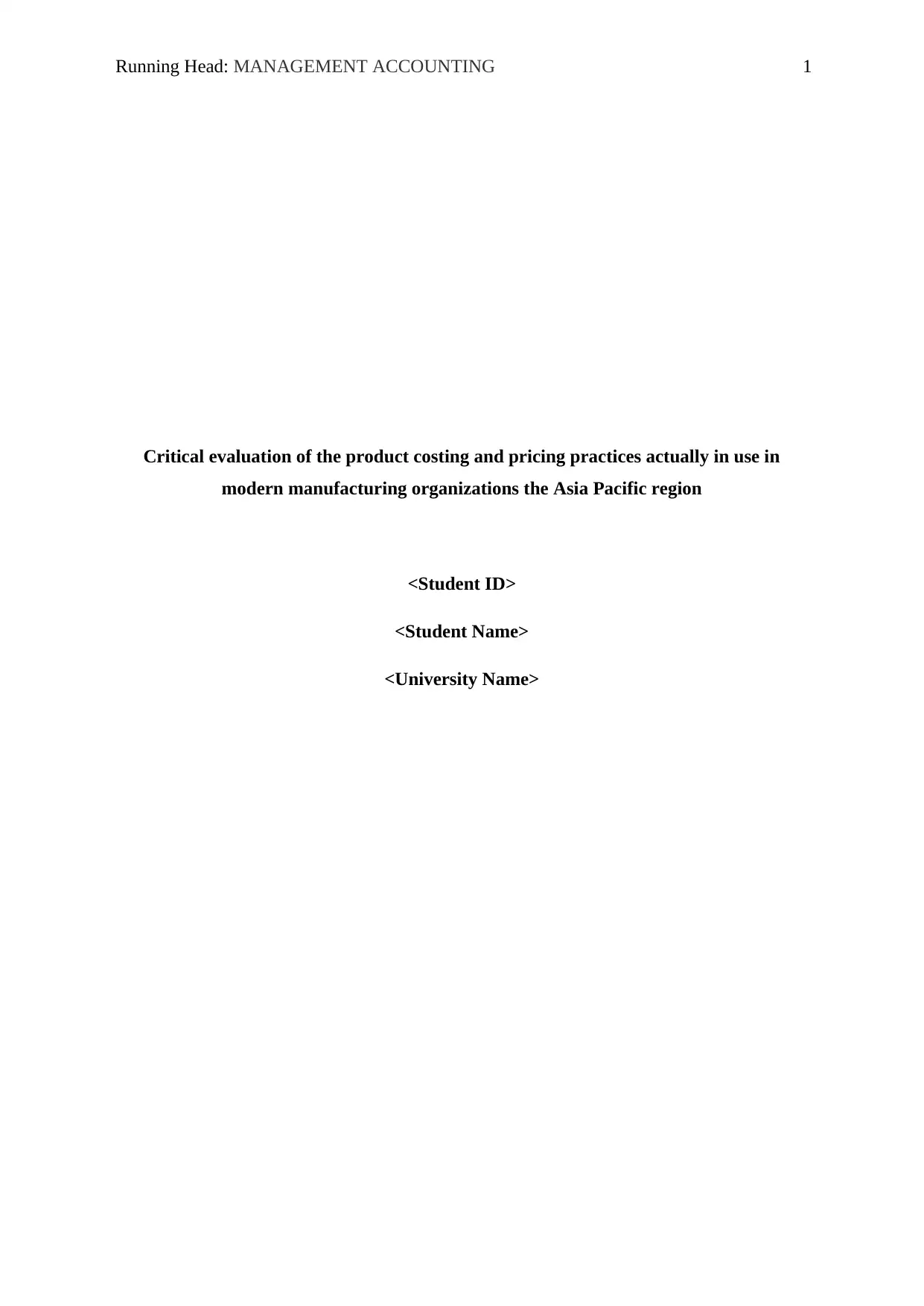
Running Head: MANAGEMENT ACCOUNTING 1
Critical evaluation of the product costing and pricing practices actually in use in
modern manufacturing organizations the Asia Pacific region
<Student ID>
<Student Name>
<University Name>
Critical evaluation of the product costing and pricing practices actually in use in
modern manufacturing organizations the Asia Pacific region
<Student ID>
<Student Name>
<University Name>
Paraphrase This Document
Need a fresh take? Get an instant paraphrase of this document with our AI Paraphraser
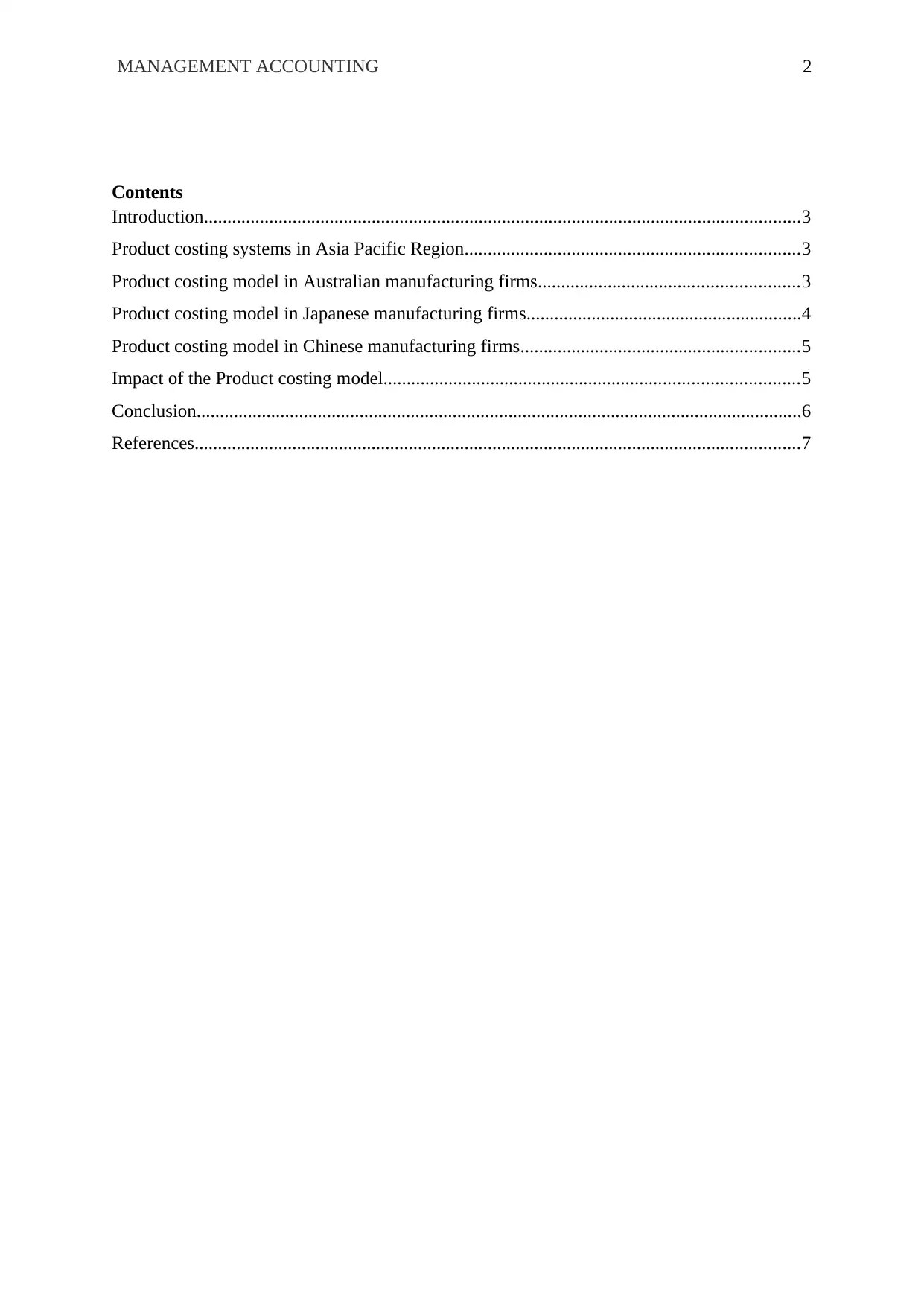
MANAGEMENT ACCOUNTING 2
Contents
Introduction................................................................................................................................3
Product costing systems in Asia Pacific Region........................................................................3
Product costing model in Australian manufacturing firms........................................................3
Product costing model in Japanese manufacturing firms...........................................................4
Product costing model in Chinese manufacturing firms............................................................5
Impact of the Product costing model.........................................................................................5
Conclusion..................................................................................................................................6
References..................................................................................................................................7
Contents
Introduction................................................................................................................................3
Product costing systems in Asia Pacific Region........................................................................3
Product costing model in Australian manufacturing firms........................................................3
Product costing model in Japanese manufacturing firms...........................................................4
Product costing model in Chinese manufacturing firms............................................................5
Impact of the Product costing model.........................................................................................5
Conclusion..................................................................................................................................6
References..................................................................................................................................7
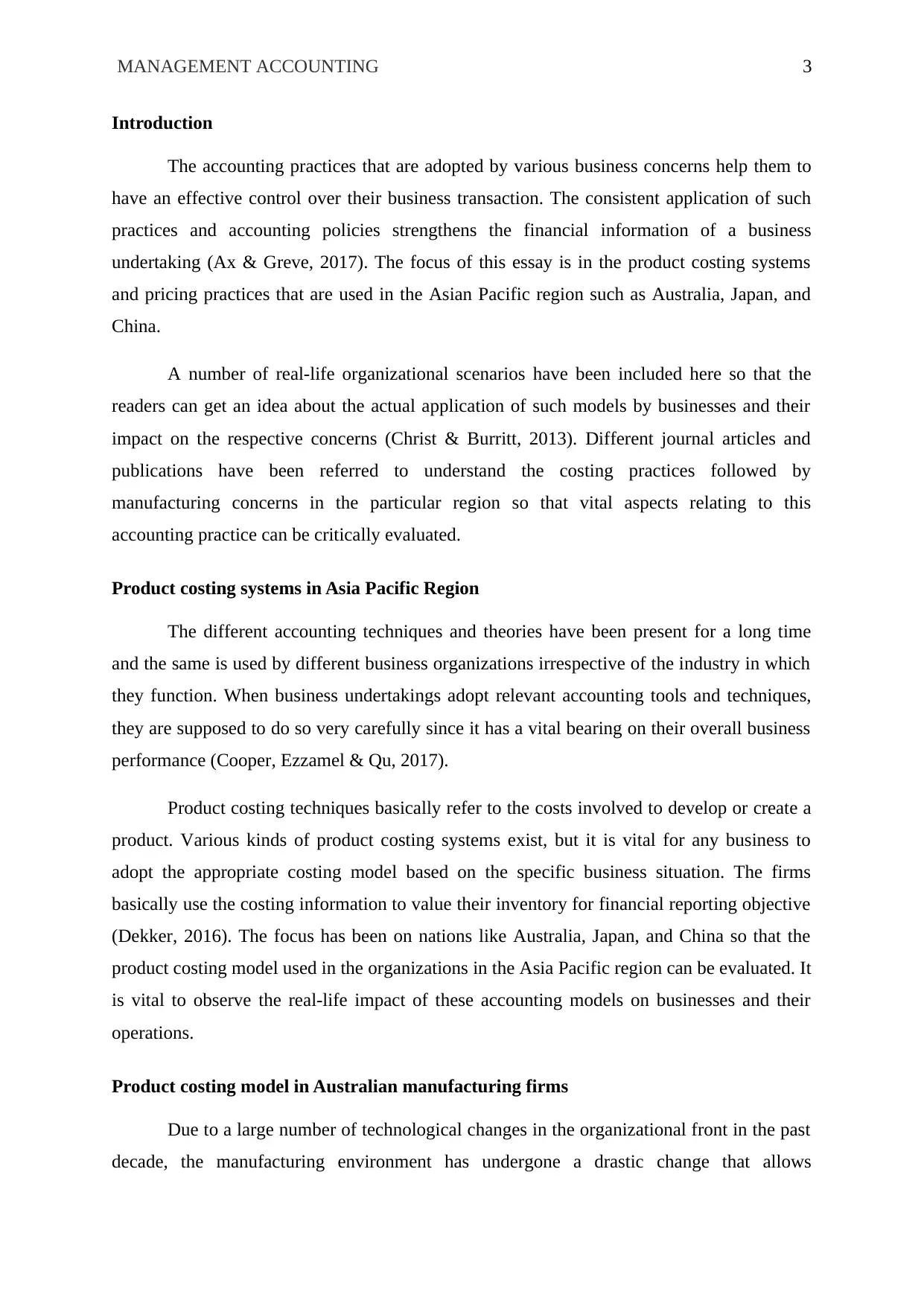
MANAGEMENT ACCOUNTING 3
Introduction
The accounting practices that are adopted by various business concerns help them to
have an effective control over their business transaction. The consistent application of such
practices and accounting policies strengthens the financial information of a business
undertaking (Ax & Greve, 2017). The focus of this essay is in the product costing systems
and pricing practices that are used in the Asian Pacific region such as Australia, Japan, and
China.
A number of real-life organizational scenarios have been included here so that the
readers can get an idea about the actual application of such models by businesses and their
impact on the respective concerns (Christ & Burritt, 2013). Different journal articles and
publications have been referred to understand the costing practices followed by
manufacturing concerns in the particular region so that vital aspects relating to this
accounting practice can be critically evaluated.
Product costing systems in Asia Pacific Region
The different accounting techniques and theories have been present for a long time
and the same is used by different business organizations irrespective of the industry in which
they function. When business undertakings adopt relevant accounting tools and techniques,
they are supposed to do so very carefully since it has a vital bearing on their overall business
performance (Cooper, Ezzamel & Qu, 2017).
Product costing techniques basically refer to the costs involved to develop or create a
product. Various kinds of product costing systems exist, but it is vital for any business to
adopt the appropriate costing model based on the specific business situation. The firms
basically use the costing information to value their inventory for financial reporting objective
(Dekker, 2016). The focus has been on nations like Australia, Japan, and China so that the
product costing model used in the organizations in the Asia Pacific region can be evaluated. It
is vital to observe the real-life impact of these accounting models on businesses and their
operations.
Product costing model in Australian manufacturing firms
Due to a large number of technological changes in the organizational front in the past
decade, the manufacturing environment has undergone a drastic change that allows
Introduction
The accounting practices that are adopted by various business concerns help them to
have an effective control over their business transaction. The consistent application of such
practices and accounting policies strengthens the financial information of a business
undertaking (Ax & Greve, 2017). The focus of this essay is in the product costing systems
and pricing practices that are used in the Asian Pacific region such as Australia, Japan, and
China.
A number of real-life organizational scenarios have been included here so that the
readers can get an idea about the actual application of such models by businesses and their
impact on the respective concerns (Christ & Burritt, 2013). Different journal articles and
publications have been referred to understand the costing practices followed by
manufacturing concerns in the particular region so that vital aspects relating to this
accounting practice can be critically evaluated.
Product costing systems in Asia Pacific Region
The different accounting techniques and theories have been present for a long time
and the same is used by different business organizations irrespective of the industry in which
they function. When business undertakings adopt relevant accounting tools and techniques,
they are supposed to do so very carefully since it has a vital bearing on their overall business
performance (Cooper, Ezzamel & Qu, 2017).
Product costing techniques basically refer to the costs involved to develop or create a
product. Various kinds of product costing systems exist, but it is vital for any business to
adopt the appropriate costing model based on the specific business situation. The firms
basically use the costing information to value their inventory for financial reporting objective
(Dekker, 2016). The focus has been on nations like Australia, Japan, and China so that the
product costing model used in the organizations in the Asia Pacific region can be evaluated. It
is vital to observe the real-life impact of these accounting models on businesses and their
operations.
Product costing model in Australian manufacturing firms
Due to a large number of technological changes in the organizational front in the past
decade, the manufacturing environment has undergone a drastic change that allows
⊘ This is a preview!⊘
Do you want full access?
Subscribe today to unlock all pages.

Trusted by 1+ million students worldwide
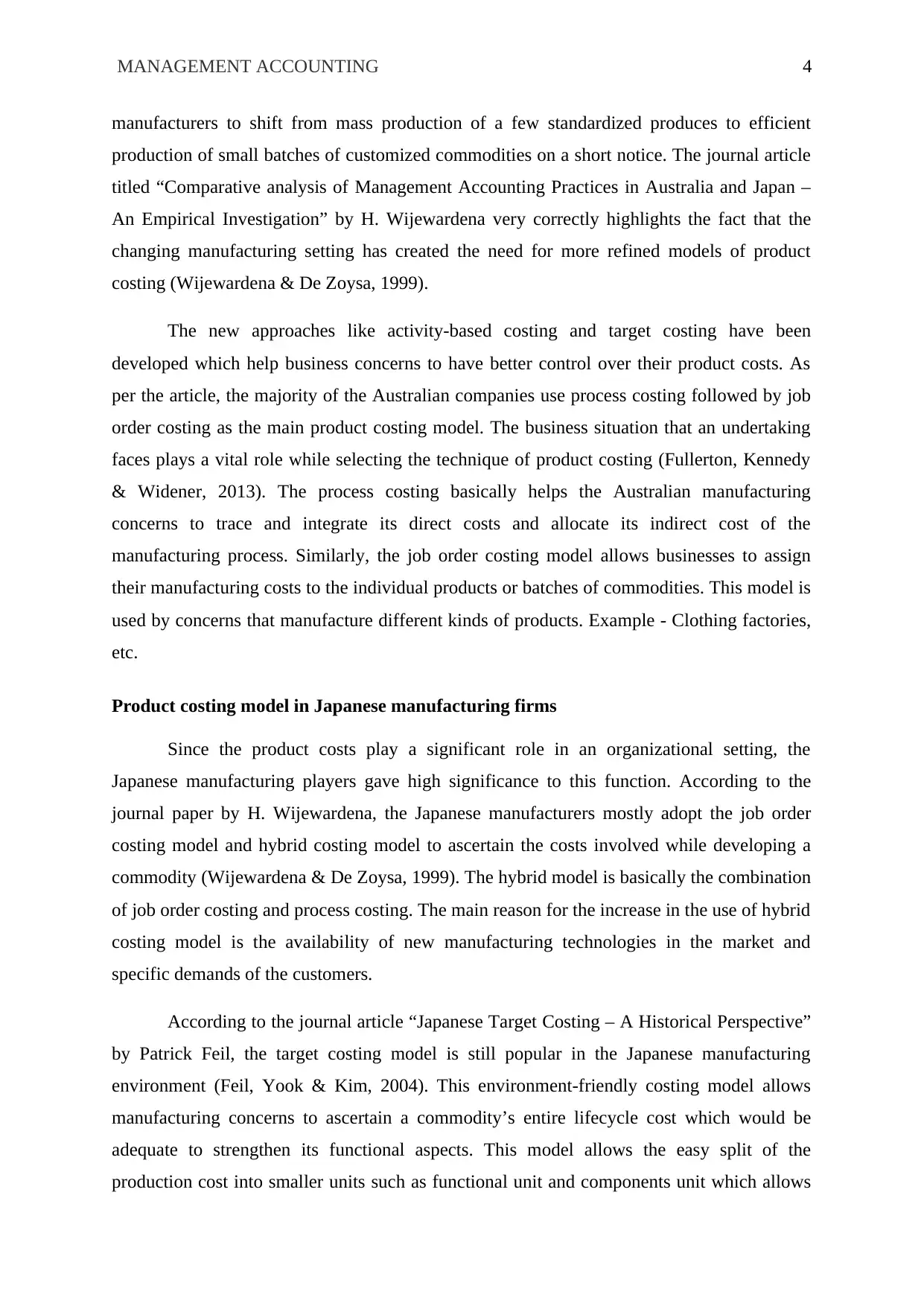
MANAGEMENT ACCOUNTING 4
manufacturers to shift from mass production of a few standardized produces to efficient
production of small batches of customized commodities on a short notice. The journal article
titled “Comparative analysis of Management Accounting Practices in Australia and Japan –
An Empirical Investigation” by H. Wijewardena very correctly highlights the fact that the
changing manufacturing setting has created the need for more refined models of product
costing (Wijewardena & De Zoysa, 1999).
The new approaches like activity-based costing and target costing have been
developed which help business concerns to have better control over their product costs. As
per the article, the majority of the Australian companies use process costing followed by job
order costing as the main product costing model. The business situation that an undertaking
faces plays a vital role while selecting the technique of product costing (Fullerton, Kennedy
& Widener, 2013). The process costing basically helps the Australian manufacturing
concerns to trace and integrate its direct costs and allocate its indirect cost of the
manufacturing process. Similarly, the job order costing model allows businesses to assign
their manufacturing costs to the individual products or batches of commodities. This model is
used by concerns that manufacture different kinds of products. Example - Clothing factories,
etc.
Product costing model in Japanese manufacturing firms
Since the product costs play a significant role in an organizational setting, the
Japanese manufacturing players gave high significance to this function. According to the
journal paper by H. Wijewardena, the Japanese manufacturers mostly adopt the job order
costing model and hybrid costing model to ascertain the costs involved while developing a
commodity (Wijewardena & De Zoysa, 1999). The hybrid model is basically the combination
of job order costing and process costing. The main reason for the increase in the use of hybrid
costing model is the availability of new manufacturing technologies in the market and
specific demands of the customers.
According to the journal article “Japanese Target Costing – A Historical Perspective”
by Patrick Feil, the target costing model is still popular in the Japanese manufacturing
environment (Feil, Yook & Kim, 2004). This environment-friendly costing model allows
manufacturing concerns to ascertain a commodity’s entire lifecycle cost which would be
adequate to strengthen its functional aspects. This model allows the easy split of the
production cost into smaller units such as functional unit and components unit which allows
manufacturers to shift from mass production of a few standardized produces to efficient
production of small batches of customized commodities on a short notice. The journal article
titled “Comparative analysis of Management Accounting Practices in Australia and Japan –
An Empirical Investigation” by H. Wijewardena very correctly highlights the fact that the
changing manufacturing setting has created the need for more refined models of product
costing (Wijewardena & De Zoysa, 1999).
The new approaches like activity-based costing and target costing have been
developed which help business concerns to have better control over their product costs. As
per the article, the majority of the Australian companies use process costing followed by job
order costing as the main product costing model. The business situation that an undertaking
faces plays a vital role while selecting the technique of product costing (Fullerton, Kennedy
& Widener, 2013). The process costing basically helps the Australian manufacturing
concerns to trace and integrate its direct costs and allocate its indirect cost of the
manufacturing process. Similarly, the job order costing model allows businesses to assign
their manufacturing costs to the individual products or batches of commodities. This model is
used by concerns that manufacture different kinds of products. Example - Clothing factories,
etc.
Product costing model in Japanese manufacturing firms
Since the product costs play a significant role in an organizational setting, the
Japanese manufacturing players gave high significance to this function. According to the
journal paper by H. Wijewardena, the Japanese manufacturers mostly adopt the job order
costing model and hybrid costing model to ascertain the costs involved while developing a
commodity (Wijewardena & De Zoysa, 1999). The hybrid model is basically the combination
of job order costing and process costing. The main reason for the increase in the use of hybrid
costing model is the availability of new manufacturing technologies in the market and
specific demands of the customers.
According to the journal article “Japanese Target Costing – A Historical Perspective”
by Patrick Feil, the target costing model is still popular in the Japanese manufacturing
environment (Feil, Yook & Kim, 2004). This environment-friendly costing model allows
manufacturing concerns to ascertain a commodity’s entire lifecycle cost which would be
adequate to strengthen its functional aspects. This model allows the easy split of the
production cost into smaller units such as functional unit and components unit which allows
Paraphrase This Document
Need a fresh take? Get an instant paraphrase of this document with our AI Paraphraser
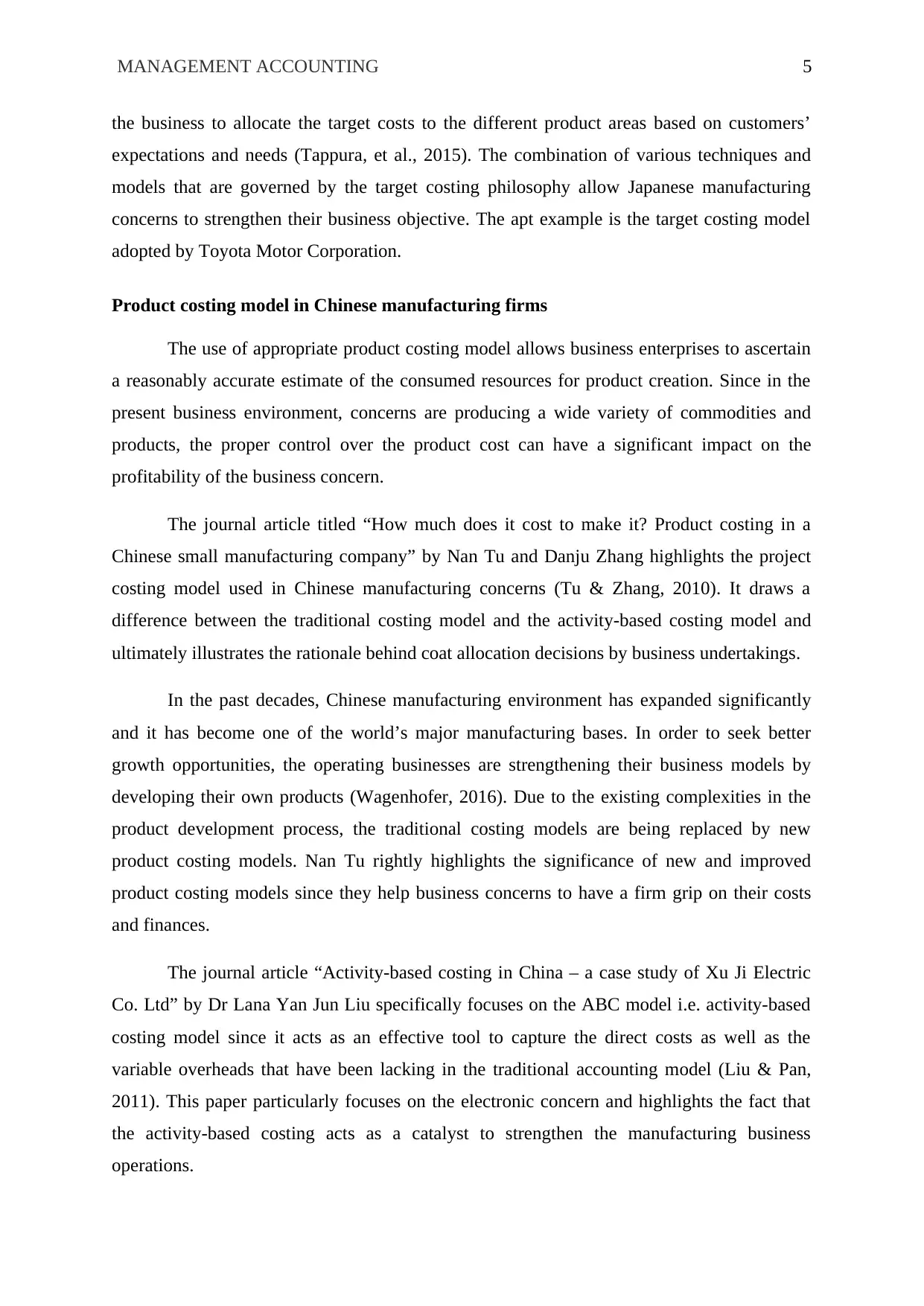
MANAGEMENT ACCOUNTING 5
the business to allocate the target costs to the different product areas based on customers’
expectations and needs (Tappura, et al., 2015). The combination of various techniques and
models that are governed by the target costing philosophy allow Japanese manufacturing
concerns to strengthen their business objective. The apt example is the target costing model
adopted by Toyota Motor Corporation.
Product costing model in Chinese manufacturing firms
The use of appropriate product costing model allows business enterprises to ascertain
a reasonably accurate estimate of the consumed resources for product creation. Since in the
present business environment, concerns are producing a wide variety of commodities and
products, the proper control over the product cost can have a significant impact on the
profitability of the business concern.
The journal article titled “How much does it cost to make it? Product costing in a
Chinese small manufacturing company” by Nan Tu and Danju Zhang highlights the project
costing model used in Chinese manufacturing concerns (Tu & Zhang, 2010). It draws a
difference between the traditional costing model and the activity-based costing model and
ultimately illustrates the rationale behind coat allocation decisions by business undertakings.
In the past decades, Chinese manufacturing environment has expanded significantly
and it has become one of the world’s major manufacturing bases. In order to seek better
growth opportunities, the operating businesses are strengthening their business models by
developing their own products (Wagenhofer, 2016). Due to the existing complexities in the
product development process, the traditional costing models are being replaced by new
product costing models. Nan Tu rightly highlights the significance of new and improved
product costing models since they help business concerns to have a firm grip on their costs
and finances.
The journal article “Activity-based costing in China – a case study of Xu Ji Electric
Co. Ltd” by Dr Lana Yan Jun Liu specifically focuses on the ABC model i.e. activity-based
costing model since it acts as an effective tool to capture the direct costs as well as the
variable overheads that have been lacking in the traditional accounting model (Liu & Pan,
2011). This paper particularly focuses on the electronic concern and highlights the fact that
the activity-based costing acts as a catalyst to strengthen the manufacturing business
operations.
the business to allocate the target costs to the different product areas based on customers’
expectations and needs (Tappura, et al., 2015). The combination of various techniques and
models that are governed by the target costing philosophy allow Japanese manufacturing
concerns to strengthen their business objective. The apt example is the target costing model
adopted by Toyota Motor Corporation.
Product costing model in Chinese manufacturing firms
The use of appropriate product costing model allows business enterprises to ascertain
a reasonably accurate estimate of the consumed resources for product creation. Since in the
present business environment, concerns are producing a wide variety of commodities and
products, the proper control over the product cost can have a significant impact on the
profitability of the business concern.
The journal article titled “How much does it cost to make it? Product costing in a
Chinese small manufacturing company” by Nan Tu and Danju Zhang highlights the project
costing model used in Chinese manufacturing concerns (Tu & Zhang, 2010). It draws a
difference between the traditional costing model and the activity-based costing model and
ultimately illustrates the rationale behind coat allocation decisions by business undertakings.
In the past decades, Chinese manufacturing environment has expanded significantly
and it has become one of the world’s major manufacturing bases. In order to seek better
growth opportunities, the operating businesses are strengthening their business models by
developing their own products (Wagenhofer, 2016). Due to the existing complexities in the
product development process, the traditional costing models are being replaced by new
product costing models. Nan Tu rightly highlights the significance of new and improved
product costing models since they help business concerns to have a firm grip on their costs
and finances.
The journal article “Activity-based costing in China – a case study of Xu Ji Electric
Co. Ltd” by Dr Lana Yan Jun Liu specifically focuses on the ABC model i.e. activity-based
costing model since it acts as an effective tool to capture the direct costs as well as the
variable overheads that have been lacking in the traditional accounting model (Liu & Pan,
2011). This paper particularly focuses on the electronic concern and highlights the fact that
the activity-based costing acts as a catalyst to strengthen the manufacturing business
operations.
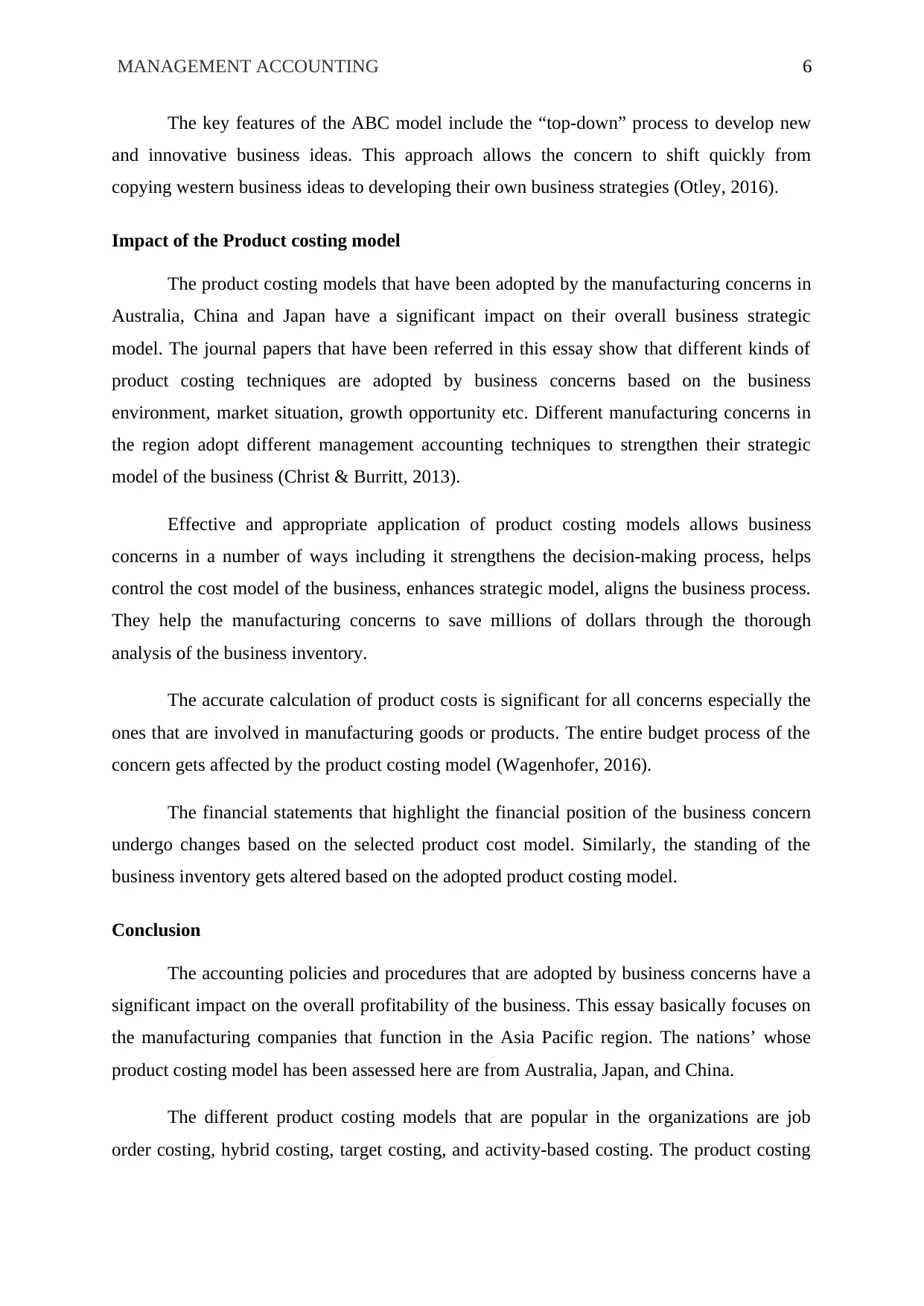
MANAGEMENT ACCOUNTING 6
The key features of the ABC model include the “top-down” process to develop new
and innovative business ideas. This approach allows the concern to shift quickly from
copying western business ideas to developing their own business strategies (Otley, 2016).
Impact of the Product costing model
The product costing models that have been adopted by the manufacturing concerns in
Australia, China and Japan have a significant impact on their overall business strategic
model. The journal papers that have been referred in this essay show that different kinds of
product costing techniques are adopted by business concerns based on the business
environment, market situation, growth opportunity etc. Different manufacturing concerns in
the region adopt different management accounting techniques to strengthen their strategic
model of the business (Christ & Burritt, 2013).
Effective and appropriate application of product costing models allows business
concerns in a number of ways including it strengthens the decision-making process, helps
control the cost model of the business, enhances strategic model, aligns the business process.
They help the manufacturing concerns to save millions of dollars through the thorough
analysis of the business inventory.
The accurate calculation of product costs is significant for all concerns especially the
ones that are involved in manufacturing goods or products. The entire budget process of the
concern gets affected by the product costing model (Wagenhofer, 2016).
The financial statements that highlight the financial position of the business concern
undergo changes based on the selected product cost model. Similarly, the standing of the
business inventory gets altered based on the adopted product costing model.
Conclusion
The accounting policies and procedures that are adopted by business concerns have a
significant impact on the overall profitability of the business. This essay basically focuses on
the manufacturing companies that function in the Asia Pacific region. The nations’ whose
product costing model has been assessed here are from Australia, Japan, and China.
The different product costing models that are popular in the organizations are job
order costing, hybrid costing, target costing, and activity-based costing. The product costing
The key features of the ABC model include the “top-down” process to develop new
and innovative business ideas. This approach allows the concern to shift quickly from
copying western business ideas to developing their own business strategies (Otley, 2016).
Impact of the Product costing model
The product costing models that have been adopted by the manufacturing concerns in
Australia, China and Japan have a significant impact on their overall business strategic
model. The journal papers that have been referred in this essay show that different kinds of
product costing techniques are adopted by business concerns based on the business
environment, market situation, growth opportunity etc. Different manufacturing concerns in
the region adopt different management accounting techniques to strengthen their strategic
model of the business (Christ & Burritt, 2013).
Effective and appropriate application of product costing models allows business
concerns in a number of ways including it strengthens the decision-making process, helps
control the cost model of the business, enhances strategic model, aligns the business process.
They help the manufacturing concerns to save millions of dollars through the thorough
analysis of the business inventory.
The accurate calculation of product costs is significant for all concerns especially the
ones that are involved in manufacturing goods or products. The entire budget process of the
concern gets affected by the product costing model (Wagenhofer, 2016).
The financial statements that highlight the financial position of the business concern
undergo changes based on the selected product cost model. Similarly, the standing of the
business inventory gets altered based on the adopted product costing model.
Conclusion
The accounting policies and procedures that are adopted by business concerns have a
significant impact on the overall profitability of the business. This essay basically focuses on
the manufacturing companies that function in the Asia Pacific region. The nations’ whose
product costing model has been assessed here are from Australia, Japan, and China.
The different product costing models that are popular in the organizations are job
order costing, hybrid costing, target costing, and activity-based costing. The product costing
⊘ This is a preview!⊘
Do you want full access?
Subscribe today to unlock all pages.

Trusted by 1+ million students worldwide
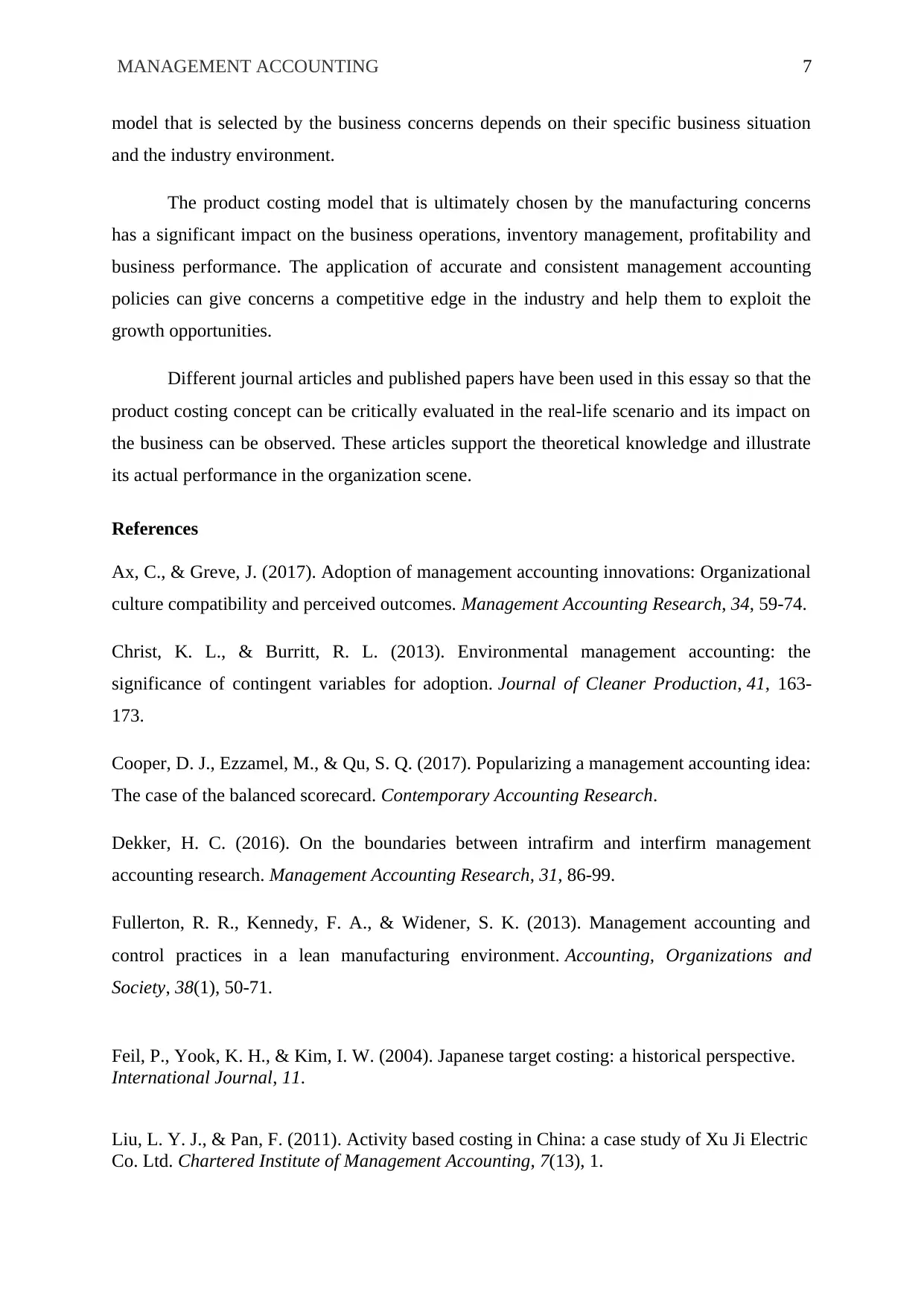
MANAGEMENT ACCOUNTING 7
model that is selected by the business concerns depends on their specific business situation
and the industry environment.
The product costing model that is ultimately chosen by the manufacturing concerns
has a significant impact on the business operations, inventory management, profitability and
business performance. The application of accurate and consistent management accounting
policies can give concerns a competitive edge in the industry and help them to exploit the
growth opportunities.
Different journal articles and published papers have been used in this essay so that the
product costing concept can be critically evaluated in the real-life scenario and its impact on
the business can be observed. These articles support the theoretical knowledge and illustrate
its actual performance in the organization scene.
References
Ax, C., & Greve, J. (2017). Adoption of management accounting innovations: Organizational
culture compatibility and perceived outcomes. Management Accounting Research, 34, 59-74.
Christ, K. L., & Burritt, R. L. (2013). Environmental management accounting: the
significance of contingent variables for adoption. Journal of Cleaner Production, 41, 163-
173.
Cooper, D. J., Ezzamel, M., & Qu, S. Q. (2017). Popularizing a management accounting idea:
The case of the balanced scorecard. Contemporary Accounting Research.
Dekker, H. C. (2016). On the boundaries between intrafirm and interfirm management
accounting research. Management Accounting Research, 31, 86-99.
Fullerton, R. R., Kennedy, F. A., & Widener, S. K. (2013). Management accounting and
control practices in a lean manufacturing environment. Accounting, Organizations and
Society, 38(1), 50-71.
Feil, P., Yook, K. H., & Kim, I. W. (2004). Japanese target costing: a historical perspective.
International Journal, 11.
Liu, L. Y. J., & Pan, F. (2011). Activity based costing in China: a case study of Xu Ji Electric
Co. Ltd. Chartered Institute of Management Accounting, 7(13), 1.
model that is selected by the business concerns depends on their specific business situation
and the industry environment.
The product costing model that is ultimately chosen by the manufacturing concerns
has a significant impact on the business operations, inventory management, profitability and
business performance. The application of accurate and consistent management accounting
policies can give concerns a competitive edge in the industry and help them to exploit the
growth opportunities.
Different journal articles and published papers have been used in this essay so that the
product costing concept can be critically evaluated in the real-life scenario and its impact on
the business can be observed. These articles support the theoretical knowledge and illustrate
its actual performance in the organization scene.
References
Ax, C., & Greve, J. (2017). Adoption of management accounting innovations: Organizational
culture compatibility and perceived outcomes. Management Accounting Research, 34, 59-74.
Christ, K. L., & Burritt, R. L. (2013). Environmental management accounting: the
significance of contingent variables for adoption. Journal of Cleaner Production, 41, 163-
173.
Cooper, D. J., Ezzamel, M., & Qu, S. Q. (2017). Popularizing a management accounting idea:
The case of the balanced scorecard. Contemporary Accounting Research.
Dekker, H. C. (2016). On the boundaries between intrafirm and interfirm management
accounting research. Management Accounting Research, 31, 86-99.
Fullerton, R. R., Kennedy, F. A., & Widener, S. K. (2013). Management accounting and
control practices in a lean manufacturing environment. Accounting, Organizations and
Society, 38(1), 50-71.
Feil, P., Yook, K. H., & Kim, I. W. (2004). Japanese target costing: a historical perspective.
International Journal, 11.
Liu, L. Y. J., & Pan, F. (2011). Activity based costing in China: a case study of Xu Ji Electric
Co. Ltd. Chartered Institute of Management Accounting, 7(13), 1.
Paraphrase This Document
Need a fresh take? Get an instant paraphrase of this document with our AI Paraphraser
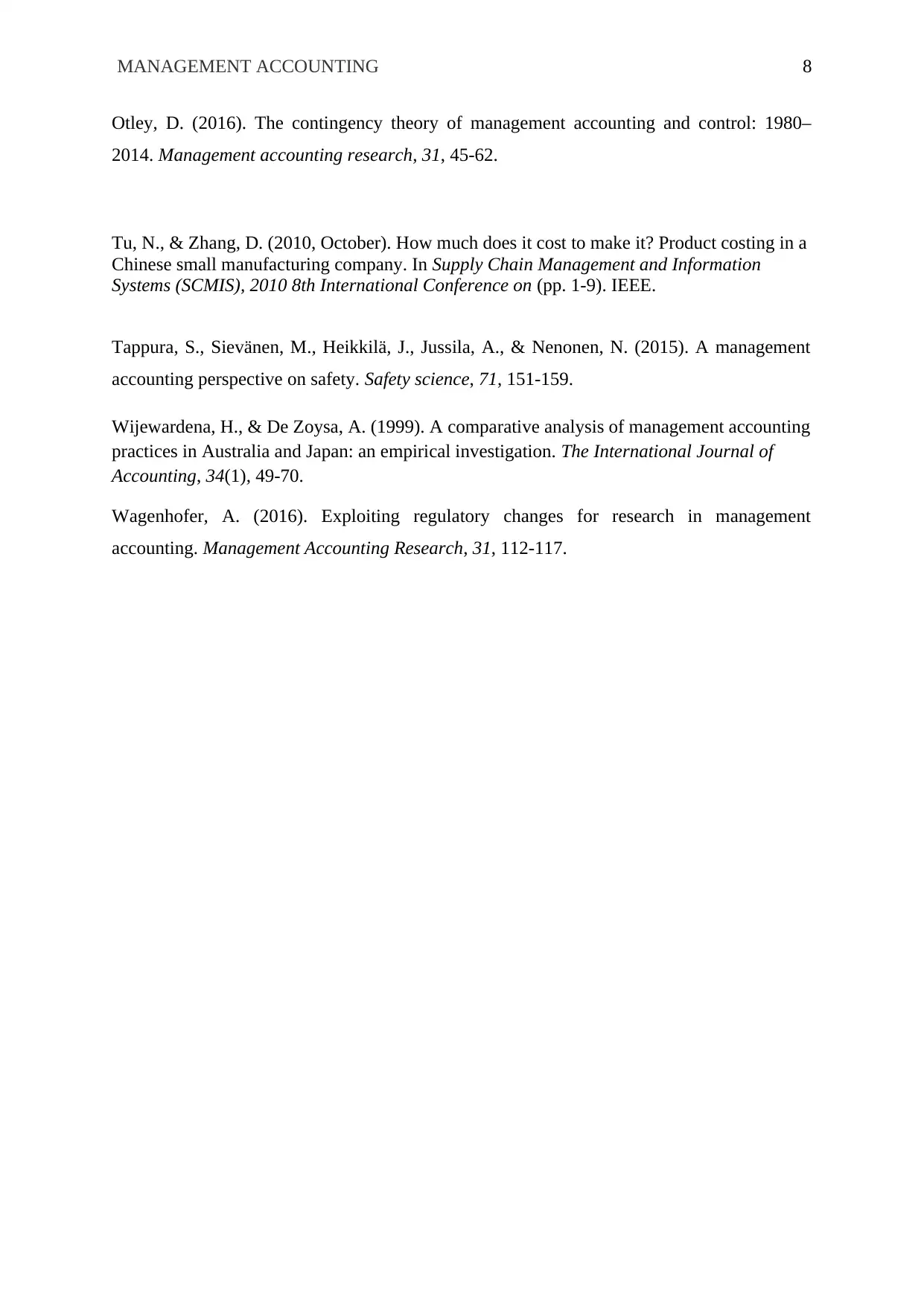
MANAGEMENT ACCOUNTING 8
Otley, D. (2016). The contingency theory of management accounting and control: 1980–
2014. Management accounting research, 31, 45-62.
Tu, N., & Zhang, D. (2010, October). How much does it cost to make it? Product costing in a
Chinese small manufacturing company. In Supply Chain Management and Information
Systems (SCMIS), 2010 8th International Conference on (pp. 1-9). IEEE.
Tappura, S., Sievänen, M., Heikkilä, J., Jussila, A., & Nenonen, N. (2015). A management
accounting perspective on safety. Safety science, 71, 151-159.
Wijewardena, H., & De Zoysa, A. (1999). A comparative analysis of management accounting
practices in Australia and Japan: an empirical investigation. The International Journal of
Accounting, 34(1), 49-70.
Wagenhofer, A. (2016). Exploiting regulatory changes for research in management
accounting. Management Accounting Research, 31, 112-117.
Otley, D. (2016). The contingency theory of management accounting and control: 1980–
2014. Management accounting research, 31, 45-62.
Tu, N., & Zhang, D. (2010, October). How much does it cost to make it? Product costing in a
Chinese small manufacturing company. In Supply Chain Management and Information
Systems (SCMIS), 2010 8th International Conference on (pp. 1-9). IEEE.
Tappura, S., Sievänen, M., Heikkilä, J., Jussila, A., & Nenonen, N. (2015). A management
accounting perspective on safety. Safety science, 71, 151-159.
Wijewardena, H., & De Zoysa, A. (1999). A comparative analysis of management accounting
practices in Australia and Japan: an empirical investigation. The International Journal of
Accounting, 34(1), 49-70.
Wagenhofer, A. (2016). Exploiting regulatory changes for research in management
accounting. Management Accounting Research, 31, 112-117.
1 out of 8
Related Documents
Your All-in-One AI-Powered Toolkit for Academic Success.
+13062052269
info@desklib.com
Available 24*7 on WhatsApp / Email
![[object Object]](/_next/static/media/star-bottom.7253800d.svg)
Unlock your academic potential
Copyright © 2020–2025 A2Z Services. All Rights Reserved. Developed and managed by ZUCOL.





